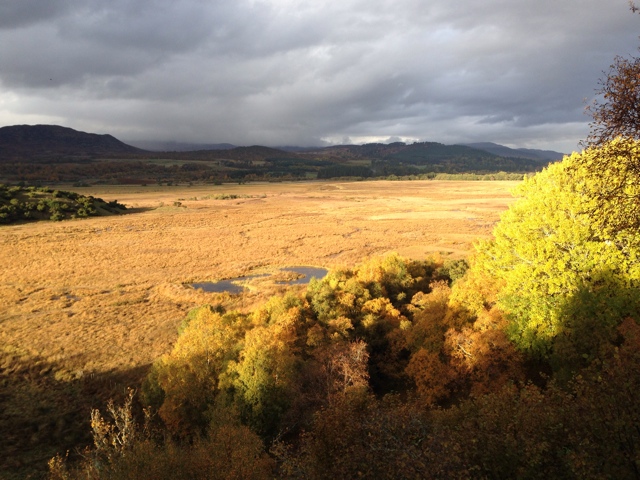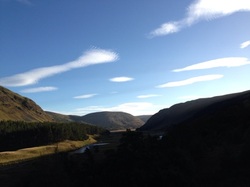With the weather turning distinctly more autumnal in the Highlands, though still relatively mild the first major influx of Redwings and Fieldfares occured this week in the Strath. On a walk out with BWWC and Gordon Hamlett yesterday morning the air was filled with the chattering of Fielfares and seeping of Redwings as we enjoyed Crested Tits and Red Squirrels on the feeders.
Later in the afternoon, the BWWC fieldtrip to Insh Marshes was treated to one of the great spectacles of bird migration with a constant stream of thrushes moving through, often just feet above our heads as we stood at the "Lookout". What a fantastic sight as they headed south, funneled at this narrow point of the Strath after feeding on the rich crop of berries further north. We picked out several small er birds in with them and the light was good enough to make out the distinct white rumps of Bramblings, as well as a few Chaffinches.
By 4 O'Clock the passage had largely stopped with only a few straglers passing when our attention was then drawn to a rather smart rusty looking juv Hen Harrier hunting the marshes below us. It was in view for the best of half an hour as it scattered Snipe and Teal with many unsuccessful grabs at them before climbing high and flying off still hungry!
Looking further ahead to next year we are busy adding more short breaks to our itinerary, keep an eye on the website for details. If you have a group wishing to visit we can offer a bespoke all in package for you or just guide hire only for the day. We use the Grant Arms "wildlife" Hotel for our accommodation where you have full use of all the facilities of the Birdwatching & Wildlife Club (BWWC) including a superb natural history library and club room.
With their being little risk of disturbance in the winter months, chances of finding a Capercaillie are much better than in spring. We know the best places to go!
Later in the afternoon, the BWWC fieldtrip to Insh Marshes was treated to one of the great spectacles of bird migration with a constant stream of thrushes moving through, often just feet above our heads as we stood at the "Lookout". What a fantastic sight as they headed south, funneled at this narrow point of the Strath after feeding on the rich crop of berries further north. We picked out several small er birds in with them and the light was good enough to make out the distinct white rumps of Bramblings, as well as a few Chaffinches.
By 4 O'Clock the passage had largely stopped with only a few straglers passing when our attention was then drawn to a rather smart rusty looking juv Hen Harrier hunting the marshes below us. It was in view for the best of half an hour as it scattered Snipe and Teal with many unsuccessful grabs at them before climbing high and flying off still hungry!
Looking further ahead to next year we are busy adding more short breaks to our itinerary, keep an eye on the website for details. If you have a group wishing to visit we can offer a bespoke all in package for you or just guide hire only for the day. We use the Grant Arms "wildlife" Hotel for our accommodation where you have full use of all the facilities of the Birdwatching & Wildlife Club (BWWC) including a superb natural history library and club room.
With their being little risk of disturbance in the winter months, chances of finding a Capercaillie are much better than in spring. We know the best places to go!


 RSS Feed
RSS Feed
